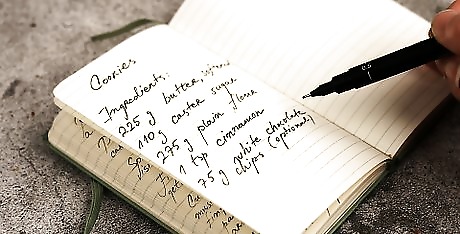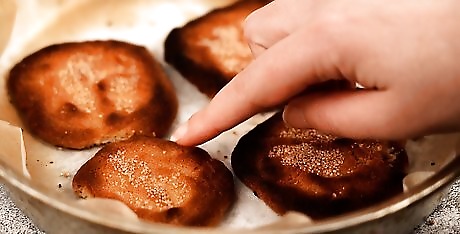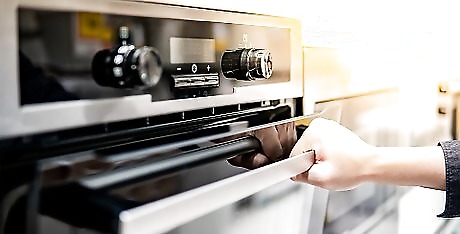
views
Signs Cookies are Done

Golden edges. Cookies with lighter dough will change color as they cook. The centers may remain a soft golden hue, while the edges may turn more dark gold or light brown. Make sure to remove the cookies before the edges turn dark brown or they'll be burnt. For example, you can test the doneness of peanut butter, oatmeal, and other drop cookies by using this method.

Cracked-open top. Cookies that contain small amounts of flour, like fudge ecstasies, show their doneness by cracking open at the center and along the edges. It's helpful to look at a photo of a done cookie before baking, so that you'll know what to expect. With these types of cookies, you'll see more firmness and an almost dull color.

Darkened crumb topping. If you've topped your cookies with brown sugar or streusel, then check to see if its coloring has changed. The topping should look golden in appearance. If you wait too long to remove your cookies, the topping can burn and turn dark brown. If your bar cookie recipe calls for placing the topping on towards the end of baking, you'll need to keep close watch on the crumbles to make sure they don't burn. The cookie's interior is usually fully cooked by this point.

Slightly puffy. When a light-colored cookie is done, it should hold its shape. However, it may look a bit puffy or soft in the center, too. This is normal and simply means that the cookie may continue baking on the sheet and rack once removed from the oven. Taking cookies out of the oven at this stage will make them softer and chewier. Whereas, overcooking can create brittleness.

Avoid relying on visual indicators when baking dark-colored cookies. In many cases, when darker cookies begin to deepen noticeably in color it means that they are already overdone. To avoid this, it's best to check for doneness using physical methods, not visual ones.
Timing Your Cookies

Follow the recipe's directions. Read the recipe carefully before starting to mix or bake cookies. You may need to place the cookie sheet on a certain rack or even change the temperature mid-baking. If you choose to alter the ingredients in any way, be aware that this might change the baking times or temperature.

Use a timer and set it to the minimum bake time. As soon as you've placed the cookies into your oven, set a standalone kitchen timer or program the one on your oven. This will let you closely monitor for doneness and avoid burning your cookies. Make sure that the timer's buzzer is loud enough, so that you'll hear it wherever you are in the house.

Check cookies at one minute intervals when the time is up. If you test the cookies for doneness at the minimum time and they aren't done, then you'll want to keep a close eye on them moving forward. As each minute passes, either peer through the glass door of the oven or open it up and perform another check. Be aware that this isn't something you'd want to do throughout the entire cooking time, just at the very end. Opening the oven does change the interior temperature.
Doing a Physical Check

Press the edges with your finger. Open up the oven, pull out the rack a bit, and push the sides of the cookie very lightly with a spatula or your finger. If the edge stays firm and doesn't fall inwards, then your cookies are done. If you leave a noticeable indentation, then your cookies likely need a few minutes more in the oven. This is an especially good method to use with dark cookies, such as chocolate or gingerbread, where coloring isn't the best indication of doneness. If you choose to use your finger to test, make sure to be very careful or you could get burned by the baking sheet. If you are working with a fragile cookie, like shortbread, test them by pressing lightly into the center instead of the edges. This will lower the likelihood of them breaking up upon contact.

Lift the cookie up to check the bottom. Pull open your oven and slide your metal spatula halfway under a single cookie. Lift up just a bit and check the coloring of the cookie's underside. The cookie should appear light brown or golden in coloring and firm in texture. Be very careful when lifting or you could split the cookie in half. This method works well for sandies, spritz, and other pale colored cookies.

Insert a toothpick into bar cookies. It's sometimes hard to test the doneness of bar cookies because they are so dense and often dark in coloring. Get a wooden toothpick or skewer and push it into the bar. Keep going until you reach the halfway point of the cookie. Withdraw the toothpick. If there are lots of crumbs or batter on the wood, then the cookies are not quite done. It's important to use wood skewers or toothpicks. Metal ones do not work as well as the crumbs will simply slide off.
Creating Good Baking Conditions

Check your oven's temperature. Get an oven thermometer and use it to see if your oven is reaching the right temperature. These are usually fairly cheap to purchase and can save you many batches of burnt cookies and other items. Baking at lower temperatures might make your cookies completely crunchy, without any chewy bits.

Adjust the baking time and temperature depending on your cookie sheet. Darker sheets hold in the heat, so you may need to reduce the baking time. Shiny sheets reflect heat outwards, so you may need to add a minute or two. If you find that your cookies are consistently burnt on the bottom, try lowering the baking temperature by about ten degrees.

Get rimless sheets for ease of use. Cookie sheets without side rims make it easier to slide your cookies off when they are done. They also give you room for more cookies per sheet. To keep your sheets from bending in the oven, go with a heavier metal.

Grease your sheets before baking. Get a paper towel, dip it in shortening or butter, and rub it on to your sheets. Your goal is to create a thin layer of grease. You can also use a non-stick spray. Otherwise, you can just place a piece of parchment paper on the cookie sheet.

Bake only one sheet of cookies at a time. Place this single sheet on the middle rack of your oven. If you cook more than one sheet at once, you'll likely overcrowd your oven and alter the baking time. However, if you choose to do two sheets, rotate them to ensure even baking.

Let cookies cool on the pan. After you take your cookies out of the oven, let them sit on the pan for 3 to 5 minutes. Then, lift each cookie gently with a spatula and transfer it over to a wire rack. The wire rack should sit at least 3 inches (7.6cm) off the countertop or moisture will form under the cookies.

Make adjustments for higher altitudes. If you are cooking in higher altitudes, then you may need to change your ingredients slightly and monitor your baking times even more closely. Start by experimenting with decreasing the butter, shortening, or sugar amounts if your cookies end up too large and burnt. Your baking time might also vary.

















Comments
0 comment